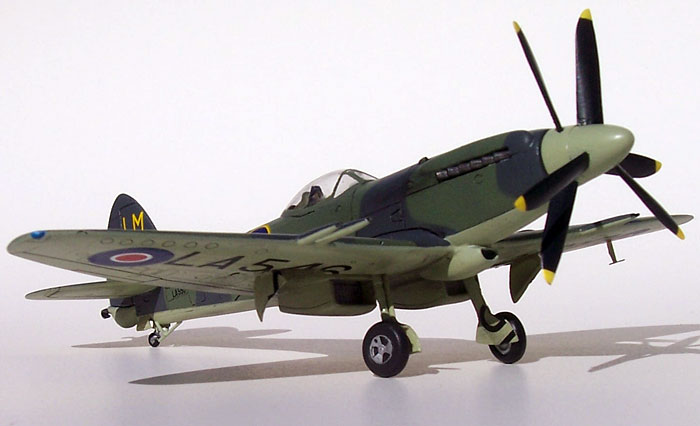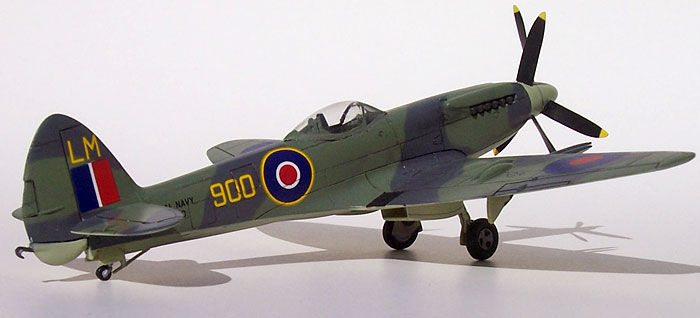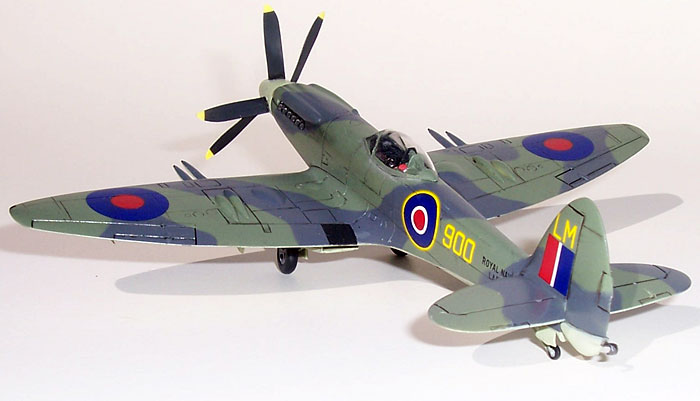|
Czech Master Resin's
1/72 scale
Supermarine
Seafire F.46
by Mark Davies
|
 |
|
Supermarine Seafire F.46 |

HyperScale is proudly supported by Squadron.com
The Seafire F.46 was the penultimate member of the Spitfire/Seafire
family (if you don’t count the Spiteful and Seafang), and was a post-war
aircraft used in limited numbers. Essentially it was a navalised version
of the Spitfire Mk 22 with a contra-rotating 6-blade prop. They survived
in service due in part to the cautious adoption of jet aircraft for
carrier use, and the consequent lack of jet-powered alternative
ship-borne fighters in the late forties and early fifties.
The late model Spitfires and Seafires are said by some to no longer
resemble “true” Spitfires following their adoption of the new wing
introduced with the Spitfire Mk 21 and the larger tail surfaces
introduced with the Mk 22. Certainly this view has been expressed
amongst a group of my modelling mates as we build various members of the
Spitfire/Seafire family as our group build project for 2007. I can
understand this point of view to some extent, although it’s hardly of
any academic importance. Personally, and purely from an aesthetics point
of view, I’m not a fan of the Mk 21. I do think that the Spitfire 22 &
24 and Seafire 46 & 47 are truly handsome aircraft in their own right,
however much their appearance may have changed from their earlier
brethren.

Czech Master Resin (CMR) produces the largest and most comprehensive
range of 1/72 scale Spitfire and Seafire kits, and continues to add to
it.
The Seafire F.46 is typical of the range, being crisply moulded with
delicate detail and straightforward construction. The wheel wells
deserve special mention for their depth and very realistic internal
wheel bulge in the upper wing’s surface. The kit offers four markings
options, and clear instructions, plus two vac-from canopies.
There is not a lot to report regarding kit construction because it is
so simple and problem free. The fit of parts is essentially comparable
to a good injected kit (but of course without locating tabs). Very
little cleaning up of parts is needed, and the castings are virtually
pin-hole free other than a couple on the wing leading edge where the
casting block attaches. These were easily fixed in a matter of minutes
with super glue and a quick sanding.
Consequently assembly was very quick, and any very slight gaps were
catered for with Mr Surfacer. All that was needed to tidy this up was a
cotton bud soaked in acetone to wipe away any excess Mr Surfacer (the
great thing about resin being its resistance to most organic solvents).
Almost before I knew it, I was ready to paint.
Prior to assembly, and aside from painting the cockpit, I also
painted the radiator/intercooler matrices before masking them and
installing them in their underwing housings. I do this with all Spitfire
and Seafire models as I am then free to spray the under-surfaces and
radiator housing interiors, needing only a sharp blade and tweezers to
lift the masking tape.
Camouflage masking was achieved with blue-tac and I used Xtracolour
paints.

I was struck by some photos of Seafire F.46’s that whilst their upper
surfaces were clean and un-worn that their under-surfaces could be
incredibly dirty and oil-stained, so my model tries to reflect this
pattern of weathering.
All in all this was a simple and most enjoyable build of a very
aggressive yet graceful looking aircraft. I think it would be a suitable
subject for anyone with only one or two resin builds under their belt,
or a first-time resin builder with confidence. From any way you look at
it, CMR’s F.46 makes for an interesting and attractive addition to the
modelling cabinet.
Click the thumbnails below to view larger
images:
[../../photogallery/photo00012347/real.htm]
Model, Images and Text
Copyright © 2007 by
Mark Davies
Page Created 10 September, 2007
Last Updated
24 December, 2007
Back to
HyperScale Main Page |
Home
| What's New |
Features |
Gallery |
Reviews |
Reference |
Forum |